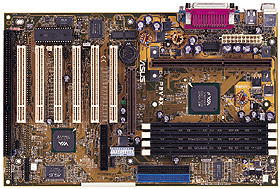VIA Apollo Pro 133/133A Motherboard Roundup - February 2000
by Anand Lal Shimpi on February 28, 2000 1:13 AM EST- Posted in
- Motherboards
|
Motherboard Specifications |
|
| CPU Interface |
Slot-1
|
| Chipset |
VIA Apollo 133A
VIA 694X North Bridge VIA 596BSouth Bridge |
| L2 Cache |
N/A (on-chip)
|
| Form Factor |
ATX
|
| Bus Speeds |
66 / 68 / 75 / 80 / 85 / 90 /
95 / 100 / 103 / 105 / 110
112 / 115 / 116 / 118 / 120 / 124 / 126 / 130 / 133 / 135 138 / 140 / 142 / 144 / 146 / 148 / 150 / 155 / 160 / 166 |
| Voltages Supported |
1.30v - 1.80v (in 0.05v increments)
|
| Memory Slots |
4 168-pin DIMM Slots
|
| Expansion Slots |
0 AMR Slots
1 AGP Slot 6 PCI Slots (6 Full Length) 1 ISA Slots (1 Shared / 1 Full Length) |
| AC'97 |
N/A
|
| BIOS |
AWARD BIOS 6.00PG
|
Just as ABIT has somewhat of a cult following, ASUS has a similar claim to fame.
While the name ASUS wasn’t associated with extreme overclocking when the ABIT BH6 was stealing the lime light during the days of the Celeron 450A combo, ASUS actually introduced the overclocking market to the 83MHz FSB frequency with their T2P4, arguably the first motherboard to ever support the 83MHz FSB frequency.
The P3V4X is the best solution for overclockers as it features a total of 32 FSB settings, and unlike other motherboards that claim support for an enormous amount of FSB settings, the P3V4X actually offers settings that can be useful to overclockers, especially when you’re overclocking the FC-PGA.
The board features ASUS’ JumperFree setup and configuration utility that resides within the board’s AWARD BIOS setup. Using the JumperFree setup you can adjust the memory clock, FSB frequency, and the voltage supplied to the CPU. The JumperFree setup will automatically select the AGP clock ratio based on your FSB selection in the BIOS, but if you want to adjust this option or any other setting manually, the P3V4X features its own set of override settings on the board that are controlled by a block of 10 dip-switches.
While ABIT may be known for their SoftMenu setup, the P3V4X puts the VA6’s SoftMenu to shame with its plethora of options that will satisfy the overclocker in all of us.
The P3V4X was one of the most reliable motherboards out of the roundup. While that would normally not be a problem at all, the reason behind its stability is what we’re questioning. ASUS has always been known for producing high quality products, and they have been known to sacrifice performance in favor of selling a more reliable product. This seems to be the case with the P3V4X as it was extremely stable in our tests, but came in last place under the gaming performance tests with a score of 78 fps under Quake III versus the 120 fps of the Gigabyte GA-6VX-4X, the fastest board in our roundup.
The only explanation for the board’s low performance under Quake III, yet seemingly normal performance under CC Winstone 2000 and SYSMark 2000, is that ASUS tweaked the board’s BIOS for stability, not performance. One setting that could have impacted the performance of the board was a setting that we originally ran into on the Tyan Trinity 400, the CPU IOQ Size option that was present in the BIOS setup. This option controls the In Order Queue size value of the chipset and should be, by default, set to a value of 4 for optimal performance.
The initial revisions of the Tyan board had this default set to 1 in order to improve stability; unfortunately, this made them take a huge performance hit under games such as Quake III. The later revisions of the board, including the latest Rev. D board that we tested have the option set to 4 by default which boosts performance significantly with seemingly no impact on stability.
Setting the CPU IOQ Size to 1 on the Tyan board resulted in Quake III performance closer to what we found with the ASUS P3V4X, further supporting our theory that ASUS simply set the default to 1 but didn’t allow for an option to change the setting in the BIOS. We will be in contact with ASUS to see if they are working on a BIOS update to resolve this situation because if they do release an update, the P3V4X can easily take the AnandTech Editor’s Choice Award for best overall 133A board in this roundup.
Another complaint we have about the P3V4X is that ASUS chose to go with the 596B South Bridge instead of the highly integrated 686A Super South Bridge. This is quite disappointing since the 686A would help to cut down on the cost of the board because it does feature an ISA slot and an ISA bridge to support that slot, the latter would be integrated into the 686A had they chosen to go with it.
For those of you that aren’t heavy gamers, the P3V4X performs perfectly fine in all business and content creation applications, and it is one of the most stable 133A boards we have tested. Hopefully with a BIOS update, ASUS can get their performance up to par with the top few boards in this roundup.











0 Comments
View All Comments